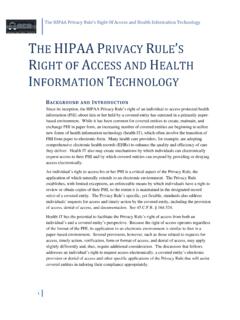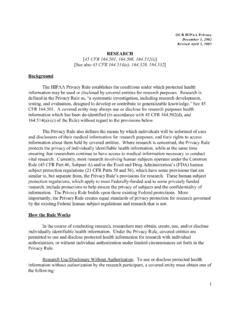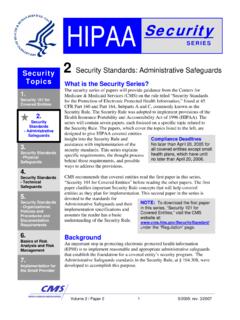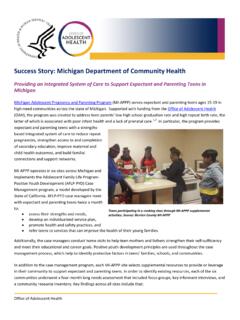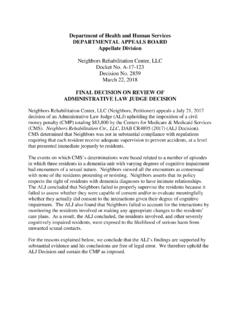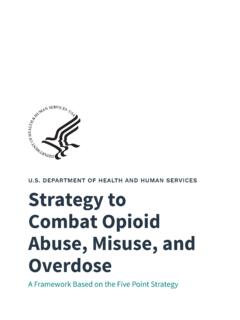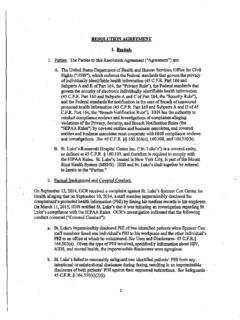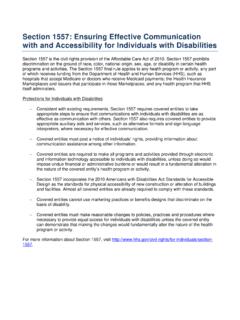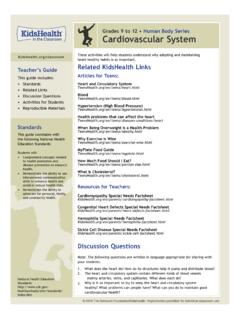Transcription of Goals and Objectives for Action - United States Department ...
1 Overview 2012 national strategy for suicide prevention : Goals and Objectives for Action What is the 2012 national strategy for suicide prevention ? The 2012 national strategy for suicide prevention (the national strategy ) is the result of a joint effort by the Office of the Surgeon General and the national Action Alliance for suicide prevention ( Action Alliance). The national strategy is a call to Action that is intended to guide suicide prevention actions in the United States over the next decade. It outlines four strategic directions with 13 Goals and 60 Objectives that are meant to work together in a synergistic way to prevent suicide in the nation. Why a national strategy for suicide prevention ? suicide is a serious public health problem that causes immeasurable pain, suffering, and loss to individuals, families, and communities nationwide. Many people may be surprised to learn that suicide was one of the top 10 causes of death in the United States in 2009. And death is only the tip of the iceberg.
2 For every person who dies by suicide , more than 30 others attempt suicide . Every suicide attempt and death affects countless other individuals. Family members, friends, coworkers, and others in the community all suffer the long-lasting consequences of suicidal behaviors. suicide places a heavy burden on the nation in terms of the emotional suffering that families and communities experience as well as the economic costs associated with medical care and lost productivity. And yet suicidal behaviors often continue to be met with silence and shame. These attitudes can be formidable barriers to providing care and support to individuals in crisis and to those who have lost a loved one to suicide . Key facts suicide is the 10th leading cause of death, claiming more than twice as many lives each year as does homicide. On average, between 2001 and 2009, more than 33,000 Americans died each year as a result of suicide , which is more than 1 person every 15 minutes. More than 8 million adults report having serious thoughts of suicide in the past year, million report making a suicide plan in the past year, and million report a suicide attempt in the past year.
3 Almost 16 percent of students in grades 9 to 12 report having seriously considered suicide , and percent report having attempted suicide one or more times in the past 12 months. 2 Recognizing the importance of suicide prevention to the nation, in 2001 Surgeon General David Satcher released the first national strategy for suicide prevention . This landmark document launched an organized effort to prevent suicide in the United States . Activity in the field of suicide prevention has grown dramatically since the national strategy was issued in 2001. Government agencies at all levels, schools, nonprofit organizations, and businesses have started programs to address suicide prevention . Important achievements include the enactment of the Garrett Lee Smith Memorial Act, the creation of the national suicide prevention Lifeline (800 273 TALK/8255) and its partnership with the Veterans Crisis Line, and the establishment of the suicide prevention Resource Center (SPRC). Other areas of progress include the increased training of clinicians and community members in the detection of suicide risk and appropriate response, and enhanced communication and collaboration between the public and private sectors on suicide prevention .
4 Why was the national strategy updated and revised? The national strategy was revised to reflect major developments in suicide prevention , research, and practice during the past decade. Examples include the following. An increased understanding of the link between suicide and other health issues. R esearch confirms that health conditions such as mental illness and substance abuse, as well as traumatic or violent events can influence a person s risk of suicide attempts later in life. Research also suggests that connectedness to family members, teachers, coworkers, community organizations, and social institutions can help protect individuals from a wide range of health problems, including suicide risk. New knowledge on groups at increased risk. Research continues to suggest important differences among various demographics in regards to suicidal thoughts and behaviors. This research emphasizes that communities and organizations must specifically address the needs of these communities when developing prevention strategies.
5 Evidence of the effectiveness of suicide prevention interventions. New evidence suggests that a number of interventions, such as behavior therapy and crisis lines, are particularly useful for helping individuals at risk for suicide . Social media and mobile apps provide new opportunities for intervention. Increased recognition of the value of comprehensive and coordinated prevention efforts. Combining new methods of treating suicidal patients with a prompt patient follow-up after they have been discharged from the hospitals is an effective suicide prevention method. 3 How is the national strategy organized? The 2012 national strategy for suicide prevention is closely aligned with the national prevention strategy , released in June 2011, which outlines the nation s plan for promoting better health and wellness among the population. This comprehensive plan seeks to increase the number of Americans who are healthy at every stage of life. Three of its seven priority areas mental and emotional well-being, preventing drug abuse and excessive alcohol use, and injury- and violence-free living are directly related to suicide prevention .
6 Like the national prevention strategy , the 2012 national strategy for suicide prevention recognizes that prevention should be woven into all aspects of our lives. Everyone businesses, educators, health care institutions, government, communities, and every single American has a role in preventing suicide and creating a healthier nation. The national strategy s Goals and Objectives fall within four strategic directions, which, when working together, may most effectively prevent suicides: 1. Create supportive environments that promote healthy and empowered individuals, families, and communities ( 4 Goals , 16 Objectives ); 2. Enhance clinical and community preventive services (3 Goals , 12 Objectives ); 3. Promote the availability of timely treatment and support services (3 Goals , 20 Objectives ); and 4. Improve suicide prevention surveillance collection, research, and evaluation (3 Goals , 12 Objectives ). Contents The 2012 national strategy for suicide prevention contains five sections and seven appendices.
7 Major contents include: An introduction to suicide prevention and overview of the 2012 national strategy . A section on each of the four strategic directions and their respective Goals and Objectives . Each section includes suggestions on what different groups can do to support the Goals and Objectives . A crosswalk from the 2001 Goals and Objectives to the 2012 Goals and Objectives . Information and resources on groups identified as having increased suicide risk. Other general suicide prevention resources. 4 This organization represents a slight change from the AIM (Awareness, Intervention, Methodology) framework adopted in the 2001 national strategy . The Awareness area has been included under Healthy and Empowered Individuals, Families, and Communities. The Goals and Objectives formerly included in the Intervention area have been spread across the first three strategic directions. Methodology has been expanded to include not only surveillance and research but also program evaluation.
8 The 2001 Goals and Objectives have been updated, revised, and in some cases, replaced to reflect advances in knowledge and areas where the proposed actions have been completed. Although some groups have higher rates of suicidal behaviors than others, the Goals and Objectives do not focus on specific populations or settings. Rather, they are meant to be adapted to meet the distinctive needs of each group, including new groups that may be identified in the future as being at an increased risk for suicidal behaviors. Information on groups currently identified as having suicide risk is presented in the Appendix. What are some of the major themes in the national strategy ? Everyone has a role in preventing suicides. The Goals and Objectives in the national strategy work together to promote wellness, increase protection, reduce risk, and promote effective treatment and recovery. From encouraging dialogue about suicidal behavior to promoting policies that support suicide prevention , the national strategy States that suicide prevention efforts should: Foster positive public dialogue, counter shame, prejudice, and silence; and build public support for suicide prevention ; Address the needs of vulnerable groups, be tailored to the cultural and situational contexts in which they are offered, and seek to eliminate disparities; Be coordinated and integrated with existing efforts a ddressing health and behavioral health and ensure continuity of care; Promote changes in systems, policies, and environments that will support and facilitate the prevention of suicide and related problems; Bring together public health and behavioral health; Promote efforts to reduce access to lethal means among individuals with identified suicide risks; and Apply the most up-to-date knowledge base for suicide prevention .
9 5 How was the national strategy revised and updated? Revisions to the national strategy were initiated and overseen by the Action Alliance, a public-private partnership of more than 200 national leaders, in collaboration with Office of the Surgeon General. Launched in September 2010, the Action Alliance is dedicated to advancing the national strategy by championing suicide prevention as a national priority, catalyzing efforts to implement high-priority Objectives , and cultivating the resources needed to sustain progress. Chaired by the Honorable John McHugh, Secretary of the Army, and the Honorable Gordon H. Smith, President and CEO of the national Association of Broadcasters, the Action Alliance brings together highly respected national leaders representing more than 200 organizations. At its core is an executive committee supported by several task forces. In 2010, the Action Alliance created the national strategy for suicide prevention Task Force, which coordinated the revision of the national strategy .
10 Chaired by Surgeon General Regina M. Benjamin and SPRC Director Jerry Reed, the task force, a public-private partnership, led efforts to weave suicide prevention into all aspects of Americans lives. Other federal entities that contributed to the national strategy include the Department of Veterans Affairs, the Department of Defense, and the Substance Abuse and Mental Health Services Administration, part of the Department of Health and Human Services. In addition to SPRC, the private sector was equally represented in the development of the national strategy . Among many private entities, guidance was given by Facebook, the Entertainment Industries Council, Mental Health Association of San Francisco, University of Illinois of Chicago, University of Rochester Medical Center, and University of Calgary, Canada. Members of the national Council for suicide prevention (NCSP) also contributed to the development of and supported the launch of the national strategy , among them the American Association of Suicidology, American Foundation for suicide prevention , Jason Foundation, Jed Foundation, national Organization for People Against suicide , Samaritans USA, suicide Awareness Voices of Education, and Yellow Ribbon suicide prevention Program.
